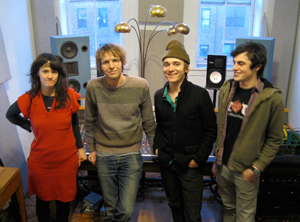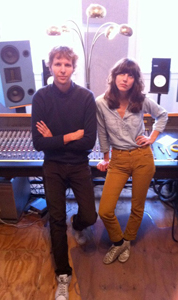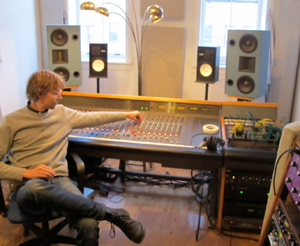Inside Stickydisc Recording with Eric Broucek
GREENPOINT, BROOKLYN: As a budding producer coming up at DFA Records’ Plantain Studios, engineering for label co-founders and producers James Murphy and Tim Goldsworthy — and artists such as LCD Soundsystem, Hercules & Love Affair, The Juan Maclean and Free Energy — Eric Broucek cut his teeth on a musical movement.
The label’s post-punk meets disco-rock purview defined a NYC sound that’s still channeling through bands around the world from Brooklyn and back. And Broucek helped establish that sound.
After serving as DFA house engineer for five years, he took off to build his own recording studio and has since co-produced and/or engineered records for !!!, The Hundred In The Hands, Free Energy, Holy Ghost!, Men, Archie Bronson Outfit and Fan Death.
Of late, Broucek has been tracking more band-oriented than dance records, most recently producing and engineering a solo record with Fiery Furnaces’ Eleanor Friedberger, and the next album by the Brooklyn-based horn-driven, funk-pop troupe, Rubblebucket.
We sat down with him for a quick chat and look around his studio, Stickydisc Recording in Greenpoint, Brooklyn:
In addition to working as an engineer for DFA, you’re also a musician and actually played in a couple DFA bands, right?
Yes, I played in The Juan Maclean for a couple years, as a touring member, playing keyboards and theremin and singing vocoder backup vocals. It was a blast. I toured around the U.S. several times, with LCD Soundsystem as well, and toured Europe and Mexico. I got to see a lot of awesome places and get that whole touring lifestyle under my belt.
It helps to have that experience to understand where bands are at when they come back from touring and feel crazy. (laughs)
Totally, so you can relate! What else did you take from DFA that you were able to implement here at Stickdisc…in terms of studio workflow? Were records made there start-to-finish?
A lot of artists on the DFA label would produce their music at home, and then bring it in to the studio to do real drums and track new parts, cut vocals and then mix. But there were some projects that were totally done from scratch there.
It was often either Tim [Goldsworthy] or James [Murphy] — the main partners — and me, because usually projects got off the ground with one person, and then the other would come in. And I was kind of the filler “other” person after awhile, and it just kind of rotated like that.
What was that dynamic like? Would you be “engineering” in the same way for both of them?
They have different skill-sets: Tim is a programmer, coming from a trip-hop world, so I would be engineering for him more than anything else. And with James, who is more a traditional rock engineer guy, I’d be on the computer or getting synths together or making sounds that we’d end up playing with. So, it was cool because I got to wear different hats with them. And I just learned through that, how I eventually wanted my studio to run and what I needed, and what I really didn’t need.
When I set up this space I wanted to keep it pretty simple, very functional and not overdo it. I didn’t need to have the fanciest equipment but I knew what I liked and what was important for getting the sounds I wanted to get — outboard reverbs, a plate, a few solid compressors (love the Purple Audio MC77), and a tape delay.
How do you tend to work with electro-based bands in your own studio – does it tend to be a similar workflow, with them coming in to track additional parts and mix what they’ve already produced at home?
It does work like that for some projects. Everybody has a computer and can record themselves so it’s a given that people are going to have production ideas. So when that kind of project comes to me, there’s often already stuff that’s set more than, say, a typical demo would be. In that case, I’ll be mixing plus doing some production — replacing or getting better sounds, etc.
On my most recent projects with Rubblebucket and Eleanor Friedberger — they’d both demoed their songs on their computers, but they don’t really try to be the producer of their own project like dance people do. And it’s been really rewarding for me to get involved at the start for the whole process so I can help suggest song arrangements and we can make a better plan for how to move forward, as opposed to just filling in what somebody’s already set in stone.
Yeah, which seems like it could feel backwards… working with an artist who’s already grown to love some early home studio sound – now you’re stuck trying to help them do that but better.
Yes, it can be frustrating. When somebody uses a GarageBand preset that happens to have a delay and a tremolo and an arpeggiator on it, and you’re wondering how that is contributing musically to the part, or to the song for that matter. You know they just picked a preset and it happened to have all those time delay effects on it. So it can become this weird battle. I’d rather just do it all from scratch!
I can see that. And cool that your latest projects were a bit more from scratch. Tell us about the Eleanor Friedberger projecct. What’s that record like?
Yeah, that was great. She is so talented and cool. The music is hard to describe. I’d say it’s more direct than a lot of the Fiery Furnaces music. Where that can sometimes be, stylistically, all over the map (in an interesting way), this is more about traditional songs. There are a lot of classic rock touchstones that we went for — kind of a 70s production style where it’s sort of naïve sounding, but not lo-fi.
What were your reference points? When you say 70s production style…
We talked about John Lennon’s solo stuff, and Phil Spector’s production style. I played her some funk and disco music I liked that she wasn’t aware of. She doesn’t really have a vocabulary of dance music, in terms of the sounds or production, so that was something I could throw at her.
That sounds like an interesting combination!
Yeah, I love the sounds of disco and reggae production. I find that to be some of the most interesting, richest sounding stuff, and those ideas can really be applied to any style of music. If you have good songs at the heart of what you’re doing, it’s so much fun to be able to bring in some of those ideas.
What are some of your favorite disco records from that era?
There was a Harlem-based label called P&P Records [the label behind SONY (Sound of New York), Queen Constance, Heavenly Star, Jay Star, Chocolate Star] – run by Patrick Adams and Peter Brown – and I really love the sound of their records. They’re really charming. I don’t tend to like the really big Studio 54 disco, but some of the outskirts of the scene are a bit stranger and headier.
So you produced and engineered the Eleanor Friedberger record? Did you do it all here at Stickydisc?
Yes, and it was the first project I did here from start to finish. She had demos that we turned into full songs. She didn’t have musicians in mind necessarily, so I brought in some friends to play on the record – Morgan Wiley on keys, Jim Orso on drums, Dylan Haney on sax. And I played guitar and bass on most of it. Eleanor played guitar. It was a lot of fun.
How did you arrive at the particular sonic palette — musically, it sounds quite a bit more sophisticated than your standard ‘indie pop.’
A lot of it was predetermined, and then some of the sounds came as a result of pushing and responding to what we’d started — hearing different things in the music that we wanted to keep pursuing. We just kept talking about records we both liked, and our communication was so easy and effortless that we were able to keep naturally pushing it to new places.
I wanted to keep it in a classic place, not really getting into using any modern studio trickery, just make it feel good. So, for example, we talked about how one song was starting to sound like a T. Rex song, and how we could push it more in that direction. We were thinking of Van Morrison, and then pushed for a saxophone solo. We agreed one of the songs was sounding kind of Kate Bush-like and we wanted to keep going with that too.
So there was room for an evolution of the sound a bit within the process. Cool. And since then, you’ve been working with Rubblebucket?
Yes, we started that at the DFA Studio, tracking everything over five days. It was a lot to do in that time. The bandleader is a trumpet player so horns are a big part of their music. And then we had a lot of percussion and vocals, organ, guitar, bass and drums.
The only reason we were able to do it that quickly is because they’re all such good musicians. All the takes worked, that part was easy, so that gave me more freedom with the sounds, and I think it ended up sounding as good as anything I’ve been able to do because of them. So, it’s rad. We recorded more vocals, horns and sounds here, and I’ve been mixing the record here.
Awesome. We look forward to hearing that! Tell us about your mixing setup here at Stickydisc. How do you tend to work?
I use a mixture of plug-ins and outboard gear. When you’re working on a big project and jumping back and forth between songs, having plug-ins that are working and setup is sometimes the best way to go. The Logic plug-ins get the job done, and I also use the UAD plug-ins a lot. I got one of the UAD-2 Quad cards so now I can put them on everything.
All the reverb I’m using is outboard. I love to be able to mix that stuff. I have a plate reverb in the other room, plus I have the Lexicon and the Ursa Major Space Station. I don’t know if I could mix fully in-the box and be as into it.
Cool, and we have to ask — what are those big blue main monitors you’ve got?
Those are actually custom DFA monitors. Only two pairs were ever made. James Murphy had this idea to make monitors and either sell them or give them to his friends, but it never really got off the ground. They have one set and I have a set. An engineer we’d worked with, who had some experience with speaker building, designed them.
So, with off-the-shelf parts, we were able to put together monitors that kind of mimic the mains at DFA, which are these big speakers with ribbon tweeters and two full range drivers, and they sound great. Really smooth.
Look out for the Eleanor Friedberger record, and the Rubblebucket album, tentatively titled Omega La La, in the coming months! And for more on Eric Broucek, visit http://www.ericbroucek.com. Contact him through Just Managing.
Please note: When you buy products through links on this page, we may earn an affiliate commission.










